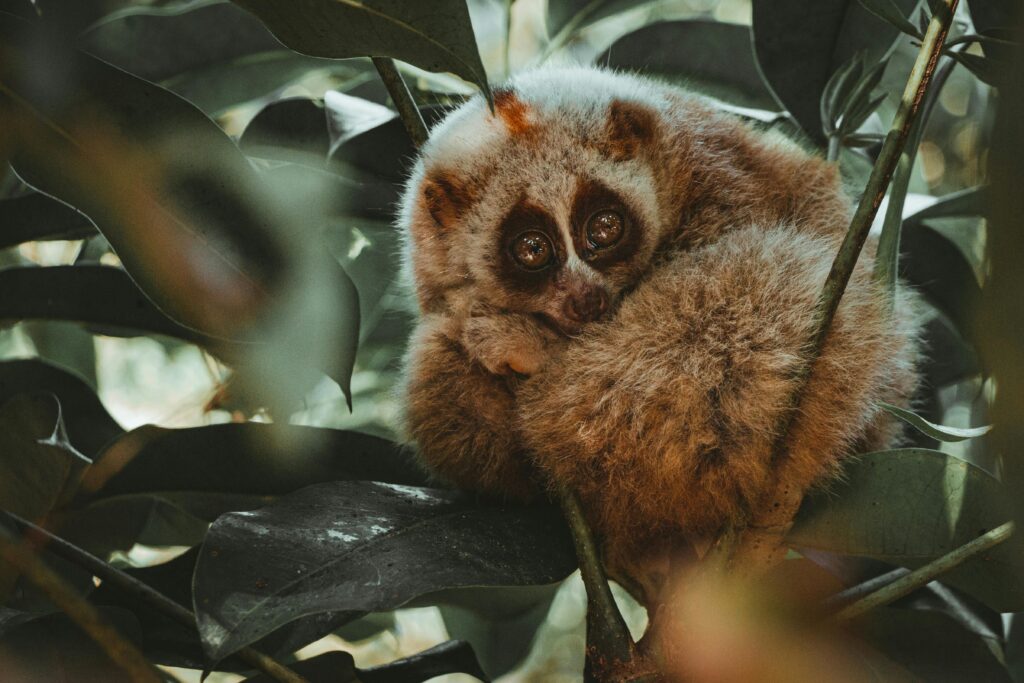
Discover the enchanting world of Slow Lorises: their habitats, behaviors, unique adaptations, and conservation efforts to protect these adorable primates
If you’ve ever come across a picture or video of a Slow Loris, chances are you were captivated by its wide, soulful eyes and slow, deliberate movements. These small, nocturnal primates seem almost otherworldly, but there’s much more to them than their cute appearance. In this article, we’ll dive deep into the world of Slow Lorises, exploring their habitats, behaviours, conservation challenges, and the fascinating adaptations that make them unique. Let’s unravel the mysteries of these adorable creatures.
What Are Slow Lorises?
Slow Lorises are a group of primates belonging to the genus Nycticebus. Native to Southeast Asia, they inhabit tropical and subtropical rainforests. With their round faces, large eyes, and slow movements, they have an almost cartoonish charm. But don’t let their cuteness fool you; these animals are full of surprises.
Physical Characteristics
One of the most striking features of the Slow Loris is its large, round eyes, perfectly adapted for their nocturnal lifestyle. Their eyes have a reflective layer called the tapetum lucidum, which enhances their night vision—a vital trait for navigating dark forests. Slow Lorises have short, dense fur that varies in colour from greyish-brown to reddish hues, depending on the species. Their hands and feet are specially adapted for gripping branches, allowing them to move stealthily through the treetops.
Unique Adaptations
What sets Slow Lorises apart from other primates is their venomous bite—a rarity among mammals. They secrete venom from a gland near their elbows, which they mix with saliva to deliver a toxic bite. This adaptation helps deter predators and plays a role in territorial disputes. However, the venom is not lethal to humans but can cause severe allergic reactions.
Where Do Slow Lorises Live?
Slow Lorises are primarily found in the dense rainforests of Southeast Asia, including countries like Indonesia, Malaysia, Thailand, and the Philippines. These forests provide the perfect environment for these arboreal creatures, offering plenty of trees for climbing and an abundance of food.
Diet and Feeding Habits
Slow Lorises are omnivorous, meaning they eat a variety of foods. Their diet includes fruits, tree gum, insects, and small animals. One of their favourite foods is sap, which they obtain by gouging holes in tree bark with their strong teeth. This slow yet efficient feeding strategy aligns perfectly with their unhurried nature.
Behaviour and Social Structure
Slow Lorises are solitary creatures, typically coming together only for mating. They communicate through vocalizations, scent markings, and even ultraviolet signals—a feature invisible to the human eye but crucial for their interactions. Their slow movements help them avoid detection by predators, earning them the nickname “masters of stealth.”
Reproduction
Female Slow Lorises give birth to a single offspring after a gestation period of about 190 days. Mothers are highly protective and carry their young for the first few months. This slow reproductive rate, combined with their long maturation period, makes population recovery challenging for these primates.
The Challenges They Face
Despite their charm, Slow Lorises face numerous threats that have pushed them to the brink of extinction. Here are some of the biggest challenges:
Habitat Loss
Deforestation for agriculture, logging, and urban development is one of the primary threats to Slow Lorises. As their habitats shrink, they are forced into fragmented areas, making survival increasingly difficult.
Illegal Wildlife Trade
Their adorable appearance has made Slow Lorises a target for the illegal pet trade. Many are captured from the wild, often with their teeth cruelly removed to prevent bites. This practice is not only inhumane but also leaves the animals defenceless.
Climate Change
Changes in climate patterns disrupt the delicate ecosystems Slow Lorises depend on. Altered rainfall and temperature patterns can affect food availability and habitat conditions.
Conservation Efforts
Thankfully, various organizations and governments are working tirelessly to protect Slow Lorises. Conservation efforts include:
- Habitat Protection: Establishing protected areas and wildlife corridors to safeguard their natural habitats.
- Anti-Poaching Measures: Strengthening laws and enforcement against the illegal pet trade.
- Community Education: Raising awareness among local communities about the importance of conserving these unique primates.
- Rehabilitation Centers: Rescuing and rehabilitating Slow Lorises before releasing them back into the wild.
How You Can Help
You don’t have to be a conservationist to make a difference. Here are some ways you can help:
- Avoid Supporting the Pet Trade: Never buy Slow Lorises or share videos that glorify them as pets.
- Support Conservation Organizations: Donate to or volunteer with groups dedicated to protecting Slow Lorises.
- Spread Awareness: Use social media to educate others about the challenges these animals face.
- Choose Sustainable Products: Opt for products that don’t contribute to deforestation.
Fun Facts About Slow Lorises
- Slow Lorises can hang upside down from branches for extended periods, thanks to their strong grip.
- Their venomous bite is thought to mimic the toxins of certain snakes, a clever evolutionary defence mechanism.
- Unlike many animals, Slow Lorises can see ultraviolet light, which they use for communication and camouflage.
- They are known to be very quiet, making only soft hisses or whistles to communicate.
Final Thoughts
Slow Lorises are more than just internet-famous animals with captivating eyes. They are a vital part of their ecosystems, playing roles in seed dispersal and pest control. However, their survival depends on us. By understanding and supporting conservation efforts, we can ensure these enchanting creatures continue to thrive in the wild for generations to come.
If you’ve fallen in love with Slow Lorises, take a moment to share this article and spread the word. Together, we can make a difference in protecting these remarkable animals.